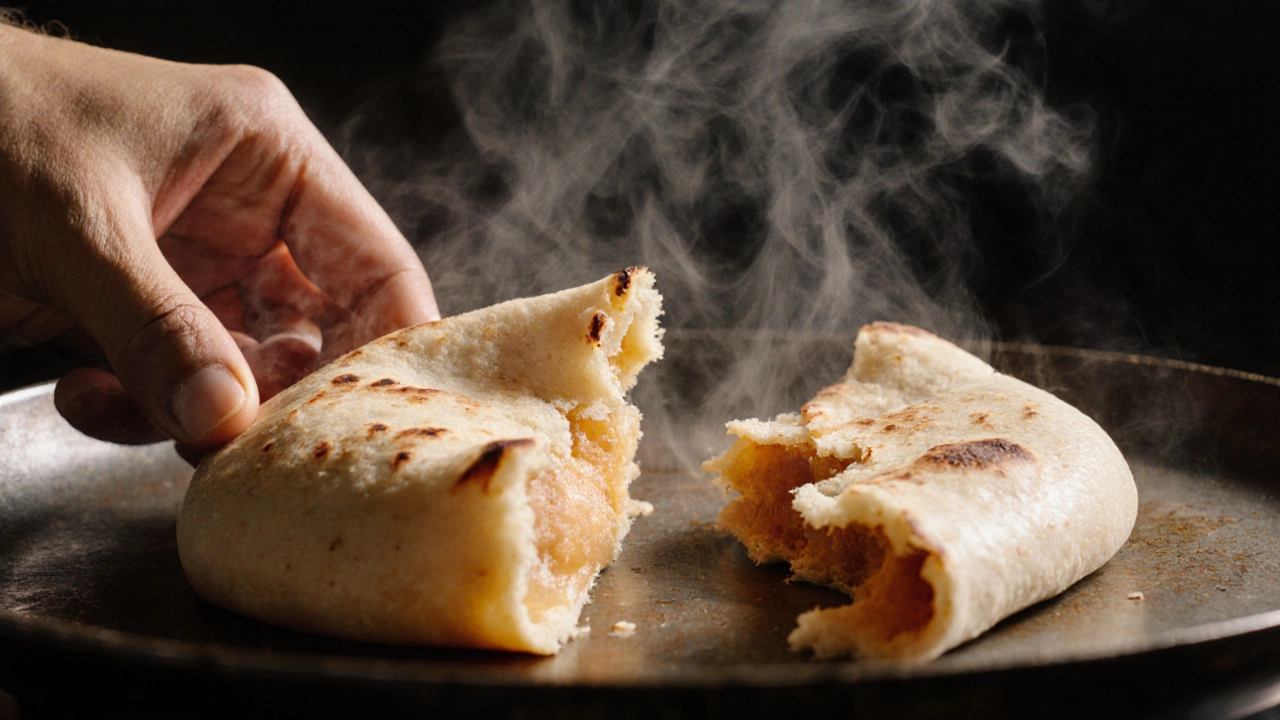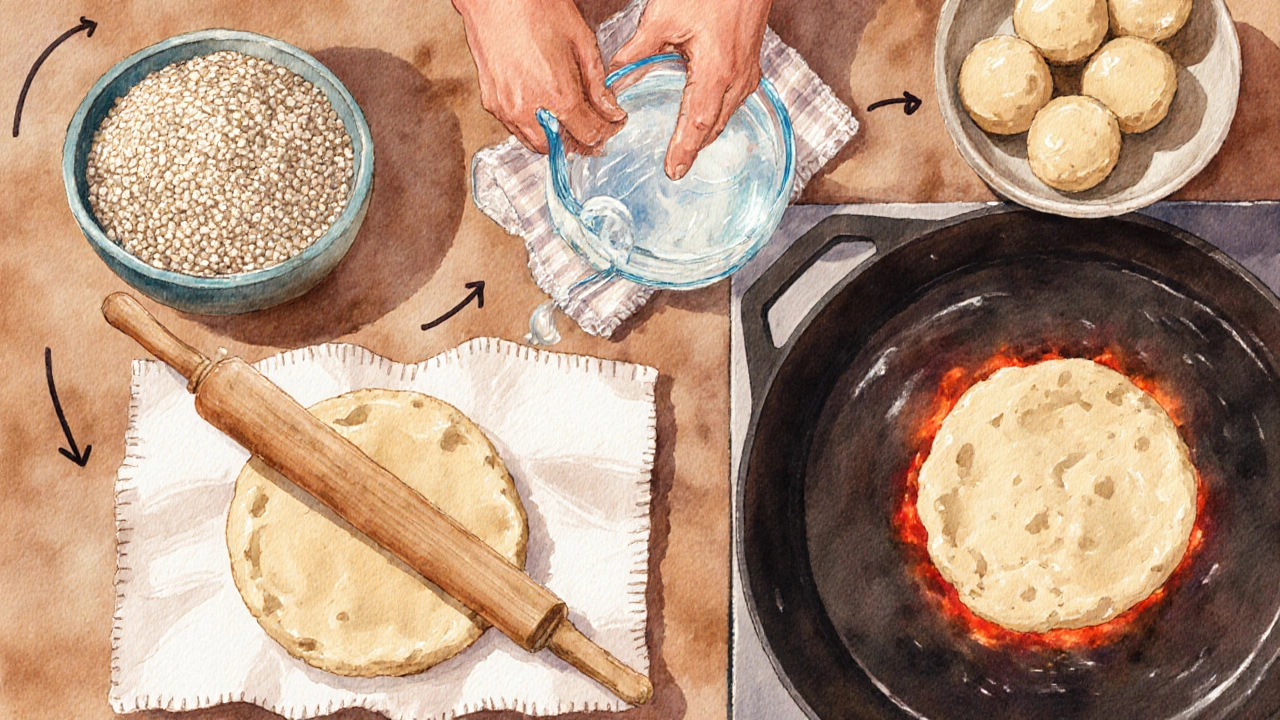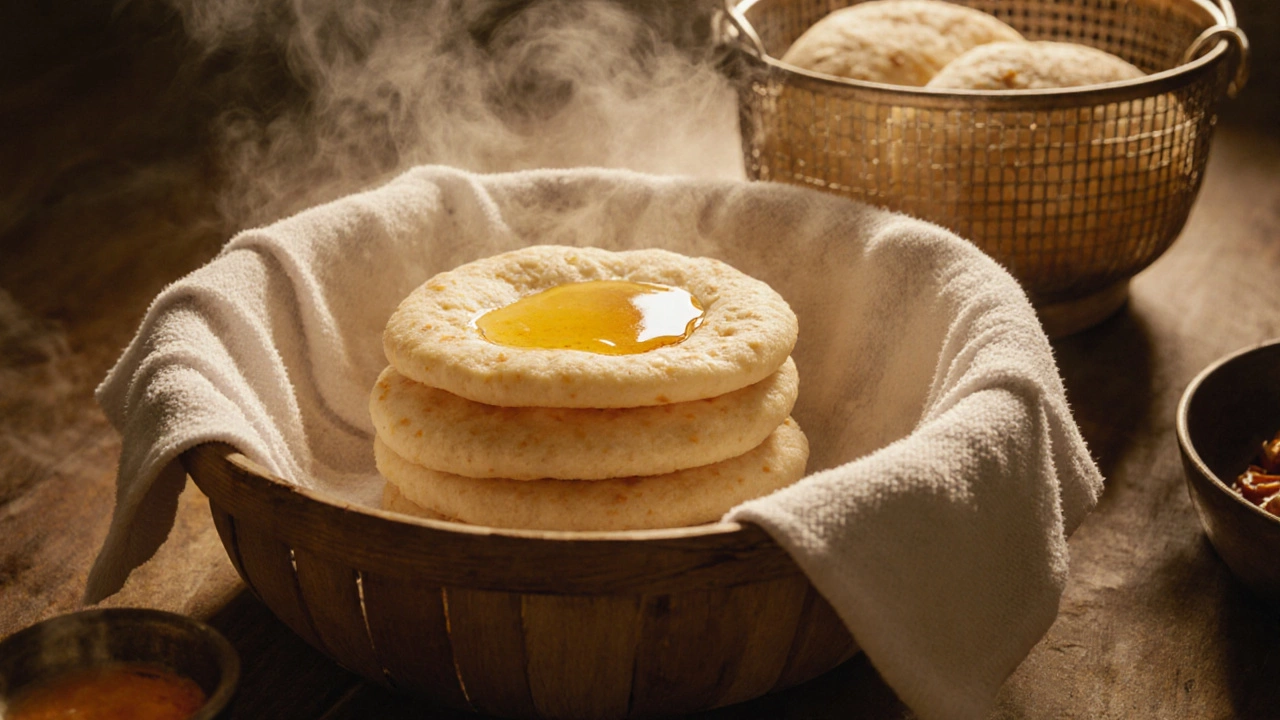Why Does Roti Get Hard After Cooking? Proven Tips to Keep It Soft
 Oct, 16 2025
Oct, 16 2025
Roti Hydration Calculator
The ideal hydration for soft roti is 60-70% (water volume relative to flour weight). This calculator helps you determine if your dough has the right moisture level.
When the first bite of a freshly made roti turns into a chewy, crusty surprise, you know something went wrong. The good news? It’s rarely a mystery. Most of the culprits are simple, measurable factors you can tweak the next time you roll out dough. Below we break down why roti gets hard, how to prevent it, and what to do if you already have a batch that’s turned tough.
What Makes a Roti Soft in the First Place?
Roti is a thin, unleavened flatbread made from whole‑wheat flour (atta) that relies on steam and a quick sear to stay pillowy. Its softness hinges on three pillars:
- Moisture balance - the dough’s hydration level should be high enough to stay pliable but not so wet that it sticks to the rolling pin.
- Gluten development - the network of gluten strands traps steam, creating the characteristic puff.
- Heat control - a hot Tawa gives the surface a quick seal while allowing moisture to stay inside.
Common Reasons Roti Turns Hard
Understanding the problem makes fixing it easier. Here are the most frequent offenders:
- Low dough hydration - Using too little water dries the dough, leaving it stiff and prone to cracking.
- Over‑kneading or under‑kneading - Either extreme damages the gluten network. Over‑kneaded dough becomes tough; under‑kneaded dough can’t trap steam.
- Insufficient resting time - Skipping the 15‑30 minute rest prevents gluten from relaxing, so the dough snaps back when rolled.
- Cooking on a cold or uneven tawa - A low temperature forces the roti to dry out before it puffs, producing a hard crust.
- Over‑cooking - Leaving the roti on the heat too long evaporates internal moisture, turning it into a cracker.
- Improper storage - Letting roti sit uncovered lets steam escape, solidifying the crumb.
Step‑by‑Step Guide to Soft Roti
Follow these precise steps and you’ll see a noticeable difference. The method assumes you have basic kitchen tools: a Rolling pin, a Tawa, and a bowl.
- Measure ingredients accurately. Use 1 cup of Atta (whole‑wheat flour) and start with ½ cup of water. Adjust by adding water a tablespoon at a time until the dough feels soft but not sticky.
- Mix & knead. Combine flour, water, a pinch of salt, and optionally ½ tsp of oil or melted Ghee. Knead for 5‑7 minutes until the dough is smooth. You should be able to stretch a small piece without it tearing.
- Rest the dough. Cover with a damp cloth and let it sit for 20‑30 minutes at room temperature. This relaxes gluten and improves hydration.
- Shape the balls. Divide the dough into equal portions (about 40‑50g each). Roll each into a smooth ball, then flatten with your palm.
- Roll out evenly. Dust the surface lightly with flour. Using the rolling pin, roll each ball into a 6‑7inch circle, aiming for uniform thickness (about 2mm). Over‑rolling creates thin spots that dry out quickly.
- Pre‑heat the tawa. Heat the tawa over medium‑high flame until a few droplets of water sizzle and evaporate instantly. The surface should be hot but not smoking.
- Cook the roti. Place the rolled dough onto the tawa. Cook for ~10‑12 seconds until small bubbles appear, then flip.
- Second side: Cook another 10‑12 seconds, press gently with a clean cloth to encourage puff.
- Final puff: When the roti balloons, press lightly again and remove from heat.
- Apply a thin layer of ghee (optional). This locks in steam and adds flavor.
- Store properly. Stack roti in a container lined with a clean kitchen towel. Cover with another towel to trap steam. They stay soft for up to 2hours.
Understanding Dough Hydration: The 60‑70% Rule
One of the most overlooked factors is the water‑to‑flour ratio, known as hydration. For soft roti, aim for 60‑70% hydration (i.e., 60‑70ml of water per 100g of flour). Below 55% the dough feels crumbly; above 75% it becomes sticky and hard to roll.
Simple test: scoop a spoonful of flour, add water gradually, and feel the texture. When the dough stops adhering to your fingers and feels supple, you’ve hit the sweet spot.

Heat Management on the Tawa
Temperature is a make‑or‑break factor. A tawa that’s too cool forces the roti to dry before steam can puff it. Conversely, a scorching tawa chars the surface instantly, sealing in steam but also creating a hard shell.
Best practice:
- Start on medium‑high heat; after 2‑3 minutes, lower to medium once you see a thin film of oil shimmering.
- Test with a small dough patch. If it bubbles within 5‑7 seconds, the temperature is right.
- Avoid using gas flames that produce uneven hot spots. A flat‑bottomed cast‑iron tawa distributes heat evenly.
Rescuing Hard Roti
Sometimes you end up with a tough batch despite best efforts. Don’t toss them-here’s how to revive them:
- Steam‑reheat. Place a hard roti in a steamer basket over boiling water for 30‑45 seconds. The steam re‑hydrates the crumb.
- Microwave with a damp paper towel. Wrap the roti in a slightly wet kitchen towel and microwave for 10‑15 seconds. The moisture re‑softens the bread.
- Butter‑sauté. Melt a teaspoon of ghee in a pan, add the roti, and heat for 15‑20 seconds on each side. The fat adds moisture and flavor.
These tricks work best for roti that’s merely dry, not burnt.
Quick Reference Table: Common Mistakes vs. Fixes
| Problem | Root Cause | Corrective Action |
|---|---|---|
| Roti cracks when flipping | Low hydration | Increase water by 1‑2 tbsp; knead longer |
| Hard crust, no puff | Cold tawa | Pre‑heat tawa until water droplets sizzle instantly |
| Chewy, rubbery texture | Over‑kneading | Knead just until smooth (5‑7 min) |
| Roti dries within minutes | Improper storage | Stack with towels inside a sealed container |
| Uneven thickness, hard edges | Uneven rolling | Roll on lightly floured surface, use consistent pressure |

Bonus Tips from Indian Kitchens
Here are a few insider tricks seasoned cooks swear by:
- Use a small amount of oil in the dough. It softens the crumb and prevents the roti from sticking to the tawa.
- Cover cooked roti with a clean kitchen towel. The trapped steam keeps each piece moist.
- Temper the dough on a cool day. If your kitchen is chilly, let the dough rest a little longer (up to 45 minutes).
- Press with a wooden spatula. After the first flip, gently press the roti with a flat spatula to encourage puff without tearing.
Key Takeaways
Roti stays soft when you balance water, respect gluten, and cook on a properly heated tawa. A quick 20‑minute rest, careful rolling, and immediate storage under a towel seal the deal. If you follow the steps above, hard roti will be a thing of the past.
Frequently Asked Questions
Why does my roti crack when I try to flip it?
Cracking usually means the dough is too dry. Increase the water by a tablespoon, let the dough rest, and roll it evenly. The extra moisture creates a flexible surface that won’t split.
Can I use all‑purpose flour instead of whole‑wheat atta?
You can, but the texture changes. All‑purpose flour has less gluten and less fiber, so the roti may be softer but less flavorful. Adjust water slightly (usually a bit less) and add a pinch of extra gluten if you want that traditional bite.
How long can I store soft roti without it getting hard?
When kept in a sealed container with a towel, roti stays soft for 2‑3 hours at room temperature. For longer storage, freeze them in a zip‑lock bag and re‑heat in a microwave with a damp towel.
Is it okay to add milk instead of water?
Yes. Milk adds a richer flavor and a slightly softer crumb because of the fat and lactose. Substitute half the water with milk and keep an eye on the dough consistency.
Why does my tawa smoke when I try to cook roti?
Too high a flame can scorch the surface, causing smoke and a hard crust. Reduce the heat to medium after the initial hot‑up phase, and wipe any excess oil before the next roti.
Can I make roti ahead of time and reheat it?
Absolutely. Store cooked roti with a towel, then reheat on a hot tawa for 10‑15 seconds per side. Adding a dab of ghee while reheating restores the soft bite.
